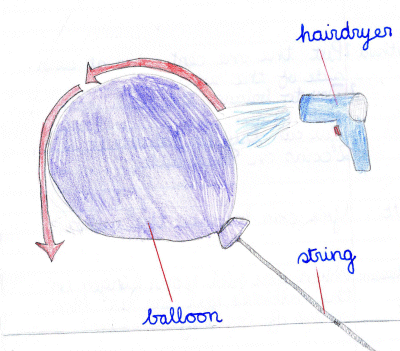Isaac Newton's Scientific Investigations 1. Newton's First Law of Motion (1) | 2. Newton's First Law of Motion (2) | 3. Newton's Third Law of Motion | 4. Newton's Colour Wheel 5. Balancing Butterfly | 6. The Floating Balloon The Floating
Balloon - Newton's First
and Second Laws - Experiment: To use Newton's first and third laws to demonstrate the 'Coanda Effect'.
Materials:
You will need:
Method: What you have to do:  1) Blow up the balloon. 2) Tie the piece of string to the balloon. 3) Get a friend to hold the end of the string over a table (or sellotape end of string to a table) 4) Blow the hair-dryer and position it so the air goes directly along the top of the balloon. Result: The balloon rises into the air.Conclusion: The balloon rises because the air from the hair-dryer is the action (according to Newton's Third Law of Motion), and the air is going around and down because the higher pressure air is pushing it towards the balloon (Newton's First Law of Motion). Moving air has lower pressure and the higher pressure in the room keeps the moving air hugging the balloon. As a result on the moving air pushing downwards, the balloon rises into the air - the reaction. The air coming from the hair-dryer is at lower pressure. The higher pressure around the balloon helps it to rise - and this is the principal behind how a plane flies, but that's for another day!
Sixth Class Experiments1. Newton's First Law of Motion (1) | 2. Newton's First Law of Motion (2) | 3. Newton's Third Law of Motion | 4. Newton's Colour Wheel 5. Balancing Butterfly | 6. The Floating Balloon | ||
